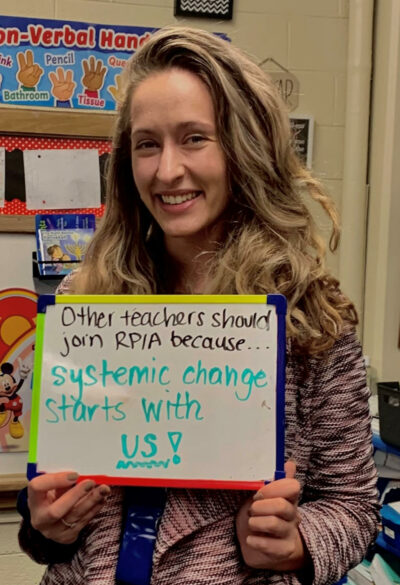DATE
April 19, 2024
AUTHOR
Erin Edinger-Turoff
CATEGORIES
Restorative Practices,Teachers
SHARE
 In my six years of teaching at Title I schools in Philadelphia, participating in the Restorative Practices in Action cohort this year has been one of the most impactful, valuable experiences I have had to date. I believe that restorative practices should be used by every educator in order to provide trauma-informed instruction and compassionate learning environments. If I were a school leader, I would want each and every one of my staff members to participate in RPIA and inform themselves about best practices to support our children. By using restorative practices, we can teach children to advocate for themselves, how to lead each other, how to leverage their individual identities and cultural experiences, and create classrooms where children are able to not only succeed, but thrive.
In my six years of teaching at Title I schools in Philadelphia, participating in the Restorative Practices in Action cohort this year has been one of the most impactful, valuable experiences I have had to date. I believe that restorative practices should be used by every educator in order to provide trauma-informed instruction and compassionate learning environments. If I were a school leader, I would want each and every one of my staff members to participate in RPIA and inform themselves about best practices to support our children. By using restorative practices, we can teach children to advocate for themselves, how to lead each other, how to leverage their individual identities and cultural experiences, and create classrooms where children are able to not only succeed, but thrive.
At the beginning of this 2021-22 school year, my 5th grade classes were struggling to adjust back to an academic year inside the school building after virtual instruction during the COVID-19 pandemic. Although they are in 5th grade, they started this school year lacking significant social and academic skills due to their isolation during lockdown in Philadelphia. Many of the behaviors students expressed were more typical of their younger peers, and children struggled to readjust to in-class participation, collaborating with their classmates, and managing their own emotions throughout the full school day. As an ELA teacher, discourse and debate among my students is very important to me. I believe that children learn best when they are able to play an integral role in their educational experiences. Due to the complicated circumstances surrounding the pandemic, I knew I had an uphill battle ahead of me to create the collaborative classroom environment I hoped for, let alone establish the sense of community among my students so that we could support each other mentally and emotionally.
RPIA teachers work to establish and prioritize student voice, ownership and empowerment within the school setting. Based on my experiences working with Claire and the RPIA coaches and cohort, I was able to use instructional strategies and practices that led to major successes. My students and I created our classroom expectations together, agreed upon the ways we wanted our classroom to operate and established practices for collaborative class discussions. I read Culturally Responsive Teaching & The Brain by Zaretta Hammond as part of my work with the cohort and learned invaluable strategies to leverage student cultural backgrounds and individual strengths or characteristics they each have. My students went from being resistant to participate in whole-group class discussions at the beginning of the year to successfully running their own discussions by April.
By using RPIA strategies like creating a Monthly Culture Plan, I was able to transform student discourse in the classroom from being dominated by a handful of outgoing students to being an inclusive academic activity, where all of the students held each other accountable for participating, asked and answered their own questions related to the discussion content, and were responsible for their own individual roles during the discussion (time keeper, scribe, talking stick manager, question manager, etc). Surveys that were distributed at various benchmarks throughout the school year showed that the majority of students went from feeling like they had no input in their own educational experience to the majority of students expressing that they have at least some influence on classroom activities.
Most importantly, my students now feel that they are part of a community – they refer to themselves as a “school family.” They stand up for each other, they advocate for themselves and each other, and they insist that we address any social conflicts as a group. For example, when they had a substitute teacher in a gym class who spoke disrespectfully to some of the students, my students reported the issue to myself and the school’s principal who was then able to address the problem and ensure that other students in the school did not also have that experience. One student who attended a different expressive arts class that day told our principal: “Even though I am not in gym with the rest of my class, I’m not OK with anyone talking to my classmates that way because we are a community and we have each others’ backs.” I cannot express how much that moment touched my heart, and how proud I was of each of my students.
We live in a country that is ravaged by the effects of white supremacy and a tumultuous, traumatic past and present. Our children have lived through epidemics of many kinds; gun violence, racism, COVID-19 and more. The education system needs to change and adapt in order to truly meet the needs and respect the humanity of our most valuable natural resource: the kids. RPIA and groups of educators like it will give us the tools to accomplish this. I will not stop advocating for social justice in education and beyond, and I truly believe that RPIA can help other educators to develop this absolutely critical perspective.


